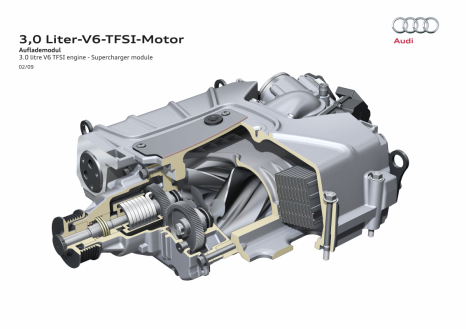Supercharger
Alongside exhaust gas turbochargers, Audi also makes use of superchargers to boost its engines. A supercharger is used in the 3.0 TFSI. The high-efficiency mechanical charger is situated in the 90-degree V formed by the cylinder banks and is driven by the engine via a poly-V belt. The gas pathways downstream of the charger are very short, thus the torque develops quickly and easily. The full boost is available even at idle.
The supercharger is located downstream of the throttle valve. Because the density of the intake air is low at engine loads below the boost level and when coasting, the supercharger’s rotors move easily when the engine has little or no need for charge air in the lower load range. Little power input is required – a good starting point for low losses and high efficiency.
Inside the so-called Roots blower, two four-vane rotary pistons similar to worm gears counter-rotate at a speed of up to 23,000 rpm, with an air gap between them measuring just a few thousandths of a millimeter. The rotary pistons can deliver 1,000 kilograms (2,204.62 lb), or 850,000 liters (30,017.47 cubic ft), of air per hour and compress it with a boost pressure of up to 0.8 bar (12 psi). An extensive suite of technical measures reduces noise from the supercharger to a minimum.
The brand with the four rings has a long tradition of supercharger technology. As early as the 1930s, the legendary Grand Prix racing cars built by Auto Union already had mechanical chargers, which coaxed as much as 440 kW (around 600 hp) of power and 850 Nm (626.93 lb-ft) of torque out of the mighty 12- and 16-cylinder engines.
Status: 2011
